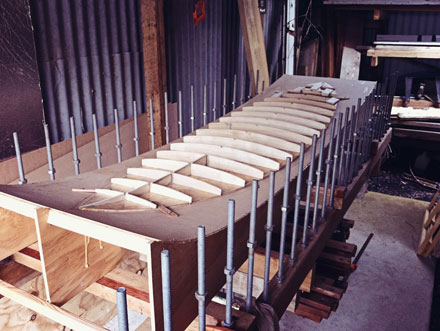
There are certain images conjured up at the mention of a surfer – a year round tan, sun-bleached hair, even perhaps a slightly “hippy” attitude to life. Glen Warren is all that and more. Source: Weekly Times Now
A carpenter by trade, the father-of-three is a keen surfer and a passionate environmental advocate.
From a small workshop in Mallacoota, Victoria’s easternmost beachside town, Mr Warren handcrafts wooden surfboards – a labour of love a long time in the making.
“I just wanted to make one for myself and one for another friend,” Mr Warren said.
“I did the first timber ones in 2008, back when there weren’t many other people doing it in Australia.
“We didn’t have anyone to learn off, so it was a bit of a trial and error process.”
Mr Warren produces about one board a month, spending dozens of hours crafting the piece from scratch.
He now has a cache of templates to choose from, but these are no “paint-by-numbers” blueprints downloaded from the internet.
Each detail has been painstakingly designed during the past eight years – from the number and specific size of each individually carved inner rail supporting the structure to the length, width and perfectly sculpted curves of the body.
“I used to be able to pump out a normal board in about six hours, but these take about 50 hours and you can’t do that all at once,” Mr Warren said.
“The time has to be spread out with waiting for glues to dry, and depending on the time of year, that can take quite a while.”
Although the goal has always been to work with native Australian timber, he is yet to make it a reality.
“I started with Hoop pine which you can buy in plywood sheets, but like a lot of Australian timbers, it was too heavy,” he said.
“We have some good marine timbers like Huon pine, but although they’re great for boat building, they’re not quite right for surfboards.”
These days, Mr Warren mostly uses an Asian native from a plantation near Coffs Harbour in NSW.
Paulownia is a light-coloured balsa wood-type timber that is fairly water resistant and plentiful in supply. It’s supplemented by smaller supplies of reclaimed Western red cedar, often in the form of window frames pulled out of old houses.
“We sometimes use the darker timber for the whole deck, but usually just for the detailing – we get all different colours of cedar and some really beautiful dark pieces, so it works really well with the Paulownia,” he said.
And, since the boards already weigh about a kilogram more than your standard new polyurethane surfboard, Mr Warren’s wife, Jade, said any additional weight would be prohibitive.
“People can get a bit funny about the extra weight on the board, but they’re not necessarily worried about any extra weight they might be carrying themselves,” she said with a laugh.
“In terms of performance boards, we can’t really compete – if people want to do aerials and other tricks then they really do need super light boards.
“But if you’re surfing big waves with a bit of chop on the top, then a heavier board can work to your advantage.”
At almost twice the price of a regular surfboard, boards from Seawood Fine Timber Surfboards don’t come cheap. But, says Mr Warren, they’re worth every cent.
“I used to go through about four boards a year and yeah, it depends on how much you surf and the conditions you surf in, but I know people who go through more than me and that’s about $800 a pop,” he said.
“We’ve surfed our boards up in Indonesia and Fiji and up and down the east coast of Australia in heavy waves and didn’t have any breakages out there.
“I’ve got boards that have had up to 600 surfs on them and are still going.”
As someone who’s in the surf on an almost daily basis, Mr Warren says the negative environmental impact of the surfing industry has been a key driving force behind his work.
“Surfing is such a nice way to get in touch with nature, but we’re surfing these things that are a big pollutant to the environment,” he said.
“The polyurethane foam, the polyester resin, it’s all derived from oil – I really just wanted to get away from the petroleum aspect of it.
“I wanted to make boards, but I didn’t want to be using those types of materials around the kids.
“When I started making them, I was doing them at home and a bit of timber dust flying around isn’t too bad, but fibreglass and foam, I didn’t want that getting into the environment and my kids’ lungs.”





